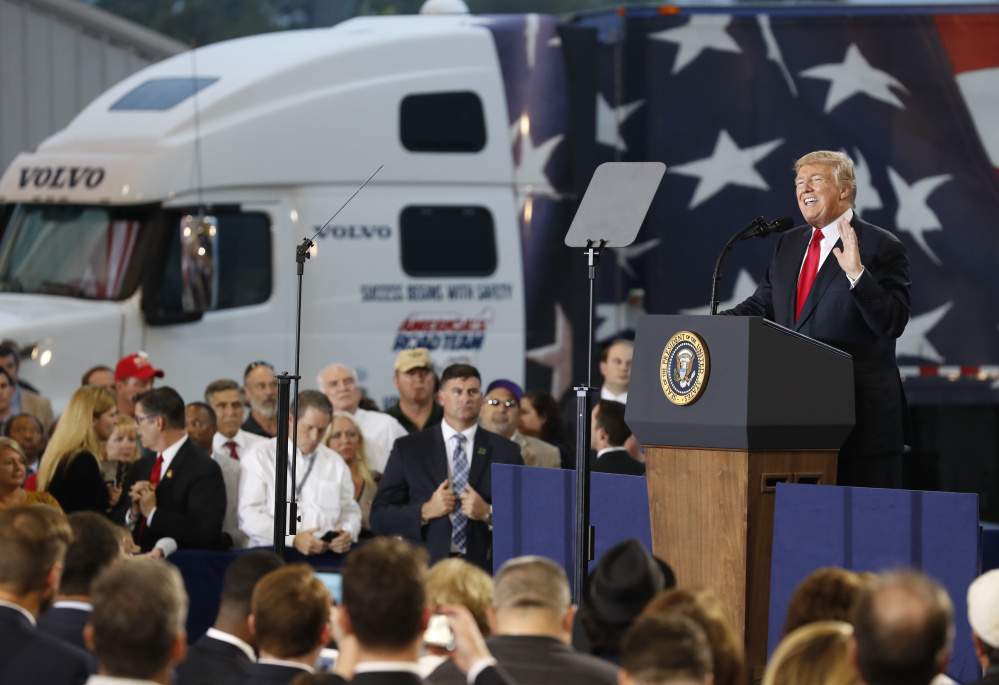MIDDLETOWN, Pa. — President Trump pitched his tax plan as a boost for truckers at an event Wednesday in Pennsylvania, saying, “America first means putting American truckers first.”
Trump appeared before about a thousand cheering people at an airplane hangar dramatically draped with American flags. Two big rigs were in the background.
“It will be rocket fuel for our economy,” Trump said of a plan that would dramatically cut corporate tax rates from 35 percent to 20 percent, reduce the number of personal income tax brackets and boost the standard deduction.
Trump said a cut to business taxes would help truckers because there will be “more products to deliver and more contracts to fill.” He also said his plan would benefit middle-class families by lowering rates, creating new jobs and making it easier for business owners to pass companies on to their children.
“So many people have come up to me and said give it to the middle class, give it to people who need it,” Trump said.
Trump is diving back into the tax fight after weeks in which his attention has shifted to rapidly emerging crises – including the mass shooting in Las Vegas and the hurricane recovery effort in Puerto Rico – as well as dramas of his own making, such as his escalating feud with Sen. Bob Corker, R-Tenn., and public tension with Secretary of State Rex Tillerson.
Taxes are the chief legislative priority for Republicans hungry for a major legislative achievement. With the 2018 campaign year looming, GOP lawmakers want something to show for their time as the majority party, and tax legislation remains their best hope.
Trump has left it up to Congress to fill in many specifics of his plan, which omits details such as the income levels for his new tax brackets. The outreach to truckers in Pennsylvania is an attempt to give a blue-collar appeal to a framework that outside tax analysts say would largely favor the wealthy.
About two-thirds of trucking firms are structured as small businesses in which the profits double as the owners’ income, what’s commonly known as “pass-through” companies, said Chris Spear, president of the American Trucking Associations.
The framework would cut the tax rate for these firms to 25 percent from 39.6 percent.
“It’s pretty critical for our membership,” Spear said.
But the liberal Center on Budget and Policy Priorities said few truckers would benefit from this preferential rate because the majority of truck drivers are employees rather than pass-through business owners, based on its analysis of Census data.
Republicans in Congress aren’t solidly behind Trump, with some from high-tax states balking because the framework calls for eliminating the federal deduction for state and local taxes. That deduction is claimed by an estimated 44 million people and costs the government an estimated $1.3 trillion in lost revenue over 10 years.
Fractious Republican lawmakers, especially those from New York, New Jersey and California, are wary of the potential financial hit to their constituents. They contend repealing the deduction would subject people to being taxed twice.
“They need our votes” on the tax plan, said Rep. Chris Collins, R-N.Y., a member of the group.
Discussions with House leaders on a possible compromise took place last week but are on hold, Collins and other lawmakers in the group said Wednesday. They said they were confident of a compromise.
Trump highlighted the tax plan’s provisions aimed at encouraging international companies to bring back, or repatriate, cash that they’ve kept overseas. All told, there’s more than $1 trillion in cash held abroad by S&P 500 companies, according to Deutsche Bank.
“We will totally eliminate the penalty on returning future earnings back to the United States and we will impose a one-time low tax on money currently parked overseas so it can be brought back home to America, where it belongs and where it can do its job,” he said. He added that his Council of Economic Advisers estimates that the change, along with a lower tax rate, “would likely give the typical American household a $4,000 pay raise.”
“Could be a lot more than that, too,” he said.
The $4,000 in additional income estimate comes from a back of the envelope calculation by White House economics adviser Kevin Hassett based on companies returning 71 percent of their foreign profits over the course of eight years.
This estimate appears to assume that the returned profits would flow to workers in the form of higher wages. But many economists say much of it would likely be returned to investors in the form of stock dividends and buybacks.
Send questions/comments to the editors.


